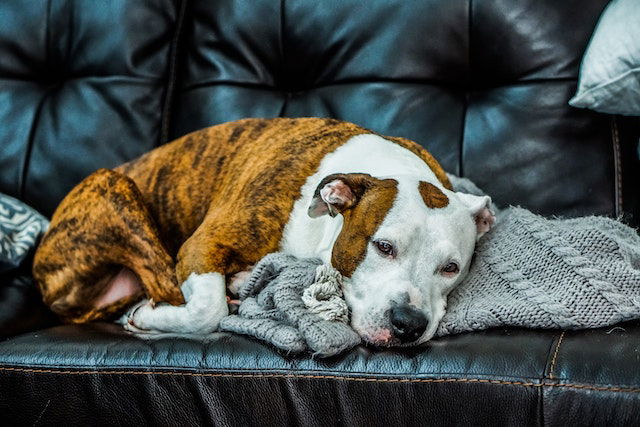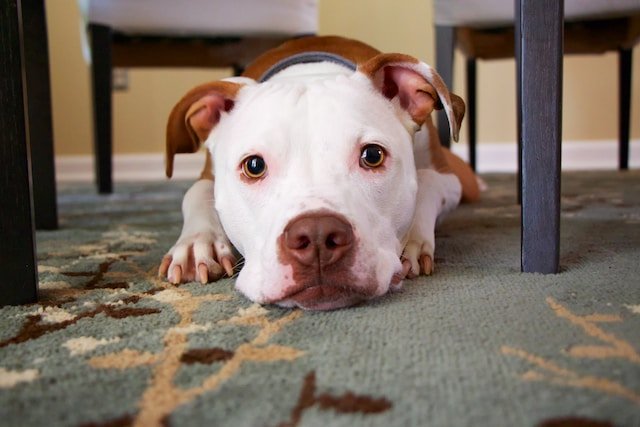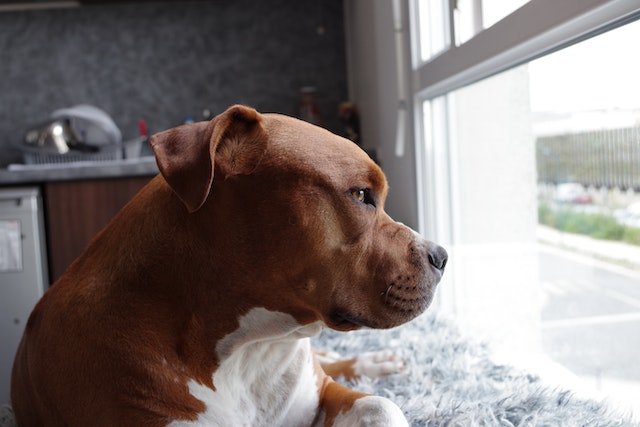We're an affiliate
We hope you love the products we recommend! Just so you know, we may collect a share of sales or other compensation from the links on this page at no additional cost to you. Thank you if you use our links, we really appreciate it!
If you are prone to allergies or concerned about Pitbull’s shedding cycle, you may be wondering if this is the best pet for you.
Unfortunately, Pitbulls are not hypoallergenic. Let’s delve into details as to why they’re not and the allergy symptoms to look out for if you own a Pitbull.
Also, keep an eye out for our practical tips on how to reduce Pitbull allergies and live with these gentle giants without suffering serious allergy symptoms.
What Does Hypoallergenic Mean?
The term ‘hypoallergenic’ means ‘less likely to cause an allergic reaction‘. An allergic reaction occurs when the human immune system becomes hypersensitive and overreacts to foreign proteins known as allergens.
The substances causing allergies are typically harmless by themselves. It is the human body’s natural response to them that causes the negative reactions.
In reference to pets, hypoallergenic dogs are less likely to trigger allergic reactions in people. Hypoallergenic dogs are therefore more compatible with hypersensitive people.
It’s important to note that all dogs produce different forms of allergens. The type of allergen and its effect may vary between individual dogs and breeds.
Some allergic individuals may tolerate certain dogs better than other breeds due to differences in the amounts and types of allergic substances produced.
Are Pitbulls Hypoallergenic?
No, Pitbulls are not hypoallergenic. Although these muscular dogs have a single coat with short fur, they can still carry many allergens which is a concern to hypersensitive individuals.

Why Are Pitbulls Not Hypoallergenic?
1. Dander and shedding
The dead skin cells on Pitbulls’ coats may flake out and form dander, which then disperses through the dog’s fur into the atmosphere in your house.
High dander production in Pitbulls is contributed to by their natural shedding cycle and the continuous flaking of dead skin cells.
Pitbulls are prone to continuously producing moderate to high amounts of dander throughout the year.
2. Presence of allergic protein in dander extracts
Dog dander is made up of specific proteins, namely Canis familiaris allergen 1 (Can f 1) and Canis familiaris allergen 2 (Can f 2), which can cause negative reactions in hypersensitive individuals.
The tiny flecks of dander can attach to your carpet, clothing, blankets, couch, or furniture, and can cause problems for allergic sufferers.
Despite the potential of Pitbulls to produce allergens, the allergenicity might vary depending on the individual dog.
Some Pitbulls may produce more dander or shed too much fur than others, depending on their skin conditions and grooming
3. Shedding and continuous release of dander
These dogs have a single coat and short fur, meaning they don’t shed as much as long-furred dogs such as Golden Retrievers.
Pitbulls can shed fur in minimal amounts throughout the year, but this still poses the risk of dander sticking to various places in the house.
4. Saliva allergens
Saliva in dogs is composed of various allergy-causing proteins including Can f 1 and Can f 2. Pitbulls tend to lick on their owners and drool, which can result in saliva being deposited on various surfaces.
If not wiped off, the saliva can dry and become dispersed into the air. The airborne particles may linger in space and cause hypersensitivity in allergic individuals.
Can You Live with a Pitbull and Have Dog Allergies?
If you suffer from pet allergies, don’t worry, you can still own a Pitbull and live with minimal reactions from their allergens.
Approximately 12% of the population in America is affected by pet allergies, but it is estimated that 86.9 million homes in America have pets.
Don’t miss the possibility of owning these lovely terrier dogs just because they are not hypoallergenic.
The good news is that with proper management and control, you can limit the allergens from your lovely Pittie.
What Are the Symptoms of Dog Allergies?
The symptoms of dog allergies result from an overreaction of the immune system in human bodies to allergenic substances.
The following are some of the common symptoms you can watch out for if you suspect dog allergies in your home:

Respiratory symptoms
- Sneezing
- Coughing
- Wheezing
Nose and eye symptoms
- Itchy eyes
- Red or watery eyes
- Swollen skin under the eye
- Runny or stuffy nose
- Itchy nose, throat, or roof of the mouth
In severe cases, dog allergies can contribute to asthmatic attacks, characterized by the following symptoms:
- Difficulty in breathing
- Chest pains
- Loud wheezing when exhaling
Skin symptoms
Some people with dog allergies may experience skin reactions to allergens known as allergic dermatitis. This normally occurs when they come into close contact with an allergy-causing dog, causing some of the following symptoms:
- Red spots after being licked by a dog
- Skin rashes (especially around the face and chest)
- Dry and itchy skin
- Eczema (inflamed patches on the skin)
- Angioedema (painless swelling under the skin)
In extreme cases of dog allergy, a severe condition called anaphylaxis can occur, in which the allergic individual may experience symptoms such as itching, hives, swelling, respiratory distress, dizziness, shock, and potentially fatal outcomes.
In general, the symptoms will get worse when the person is continually exposed to higher amounts of allergens or when different types of allergens are present.
Taking a proactive approach to reducing exposure to allergens will certainly reduce the severity of unwanted reactions.
When to see a doctor
Some of the reactions to pet allergies like sneezing and runny nose can be confused with common conditions like the common cold or flu.
If your symptoms persist for two weeks, you should check with your doctor for proper diagnosis and treatment.
How To Reduce Pitbull Allergies
People prone to allergies can still own a Pitbull despite their likelihood to produce different allergens. You can use the following strategy to reduce your chances of developing an allergic reaction:
Keeping a clean environment
1. Regular vacuuming and dusting your home
Use a vacuum cleaner fitted with HEPA filters to vacuum the sections of your home that may trap pet fur or dander.
Put more effort into the carpets, couches, pet bedding, and your bed, since these places are known to attract dog dander.
You can also use a damp cloth to dust various surfaces that may harbor pet dander, saliva, or sweat. Cleaning your home regularly also helps to keep your house tidy and prevents the spread of pathogens.
2. Using pet air purifiers and filters
Pitbulls have minimal shedding compared to long-haired breeds, but considerable shedding can be witnessed during the spring and fall when they blow off their coats for seasonal changes.
Shedding is also accompanied by the release of significant amounts of dander, which can linger in the air for quite a while.
You can invest in a high-quality air filter or purifier to filter out airborne allergens from the indoor environment.
Air filters also help in removing dust particles and other debris from the atmosphere, which improves the quality of air.
3. Minimizing carpet areas
Carpets are known to attract and retain dog dander, fur, sweat, and urine; which are all potential allergens.

If possible, you can reduce the carpeted areas on your floor or use an alternative, such as tiles, to help control dog allergies.
Bathing and Grooming Practices
4. Regular brushing
Use a soft-bristled dog brush to regularly groom your Pitbull’s coat to remove dander and weak fur.
We recommend brushing your Pitbull in an outdoor setting, or in well-ventilated areas to minimize airborne dander.
5. Regular bathing
Washing your Pitbull with hypoallergenic dog shampoo will help remove the flaked skin from their coat and soothe their inflamed skin.
Hypoallergenic dog shampoo is made with soap-free natural ingredients which helps to reduce itchiness and moisturize dry skin.
You can bathe your Pitbull monthly or as advised by your vet. It may be tempting to bathe your dog every week, but excessive bathing can strip off the natural oils from their skin which could worsen the problem.
Personal Care and Hygiene
6. Washing hands after interacting with Pitbulls
Wash your hands and face thoroughly with soap and clean water after touching, cuddling, or petting your Pitbull for a while.
Washing helps to remove dirt and all allergens that you might have picked up during the interactive sessions with your furry friend.
7. Changing clothes after prolonged contact
Getting cozy and playing with your Pitbull on the floor might transfer allergens to your clothes which can then be passed on to other surfaces.
If you had a long interactive session with your Pitbull, consider changing your clothes to put on clean ones.
8. Washing your dog’s bedding
Wash your Pitbull’s bed covers, pillows, and blankets frequently with pet-safe laundry detergent and cold water.
This will help to remove dander, fur, sweat, saliva, and tough stains that are stuck in the fabric. Laundering your Pitbull’s accessories also helps in removing foul odor and keeping the dog healthy by improving hygiene.
We recommend investing in machine-washable bedding since they are much easier to clean and maintain.
9. Using anti-allergy bedding
You can invest in allergy-resisting impermeable bedding such as mattress covers, pillow covers, and bedspreads to prevent allergens from passing through.
Allergy-proof bedding is effective against pet dander and other allergens such as dust mites, bed bugs, and pollen.
10. Creating an ‘allergy-free’ section in your home
You can designate some specific areas in your house as pet-free. These include rooms that you spend a lot of time such as the bedroom.
Such zones should have minimal to no interactions with your Pitbull, especially when they’re not brushed or bathed.
Allergy-free sections should be fitted with HEPA filters to clean the air of any airborne dirt or pet dander.
Having a pet-free room to retreat to will give you a free space where you can lounge without getting exposed to allergens.
11. Potty-train your dog
Training your dog to pee in specified areas will help prevent the spread of allergens in your house. An untrained Pitbull can eliminate on the carpet, exposing you to protein allergens in urine.
You should start potty-training your Pitbull as early as possible during their puppyhood stage.
Potty-training a Pitbull is not hard because these dogs are smart. They tend to take up behavioral training pretty fast compared to other breeds.
With consistency and a strict potty schedule, you can expect your Pitbull puppy to catch up with good potty behavior within six or eight weeks at most.
Are there Hypoallergenic Dog Breeds
While there is no 100% allergy-free dog, some pure dog breeds and cross-breeds are less likely to cause allergies to hypersensitive owners.
These dog breeds are preferable for people with pet allergies because of their non-shedding coats and lower dander production.
The following are some of the less-allergenic dog breeds:
- Afghan Hounds
- Bichon Frise
- Chinese Crested
- Kerry Blue Terrier
- Miniature Schnauzer
- Maltese
- Poodle
- Spanish Water Dogs
- Standard Schnauzer
- Labradoodle
It’s important to note that what might be hypoallergenic to someone might still be allergenic to another person. The extent of allergic reactions and symptoms might still differ from one person to the next.
If you are allergic to pets, we still recommend that you consider adopting a Pitbull, while strictly implementing practical ways to manage pet allergies.
Conclusion
Although Pitbulls have short-furred single coats, they can still trap and carry many allergens.
Dead skin cells on Pitbulls can flake off and scatter into the fur. The dander will eventually land into the air, and this is worrying for allergic individuals.
The minimal shedding, dander production, saliva, and other allergens in Pitbulls should not necessarily prevent you from owning one.
Even though Pitbulls are not hypoallergenic, they are not considered as one of the worst dog breeds for allergies.
Speak to your allergist or veterinarian about your specific allergic sensitivities to dogs, and they will work with you to develop a plan on how to live with a Pitbull at home.
Laura is the founder of Furs'n'Paws. She is a also a pet writer and expert with more than 20 years of experience of working with dogs and cats. She developed a very strong love for animals at a young age. Her passion led her to establish a thriving pet sitting and dog walking business in Dubai. As an expert in pet training, behavior, and nutrition, Laura is committed to helping pet owners and pet lovers by offering high-quality information on a wide range of topics.



No responses yet